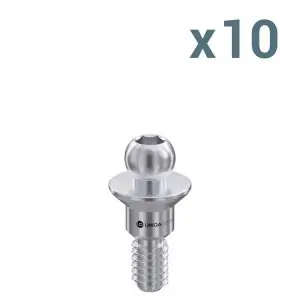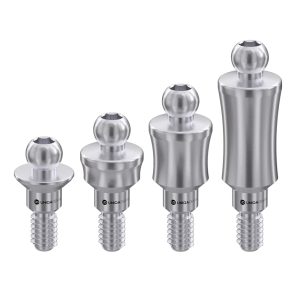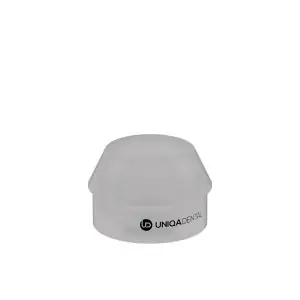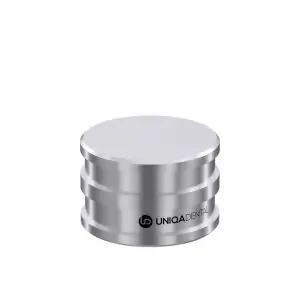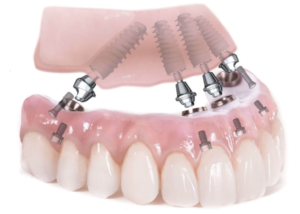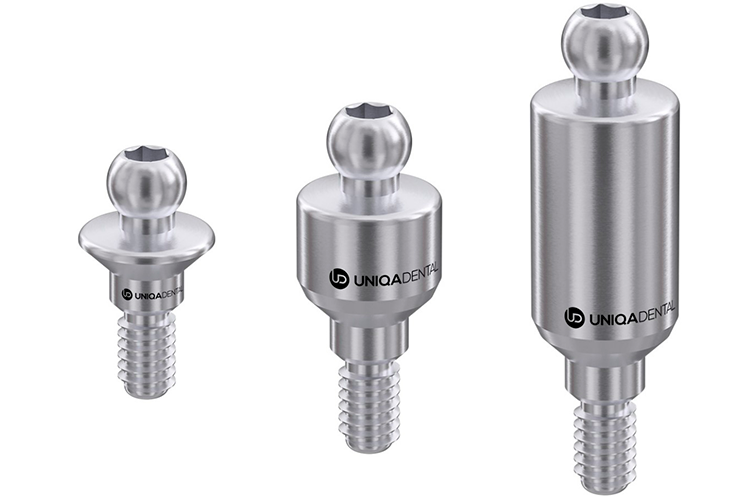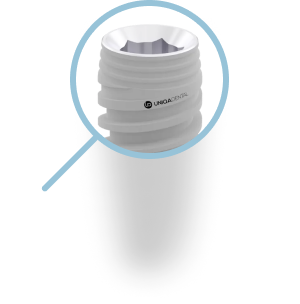Ball Attachments
Showing all 4 results
-
Hot
Abutments with Ball Attachment
In this section, you can buy ball-supported abutments for removable dentures, O-rings, elastic caps, and covers that are glued to the removable structure and rest on the ball head. Removable prostheses supported on a ball abutment are considered conditionally removable. The patient does not have to, and is not encouraged to, remove the denture on their own. This is a definite step forward compared to plate dentures, which need to be removed daily.
Advantages and Disadvantages of Ball Attachment Abutments
Dental ball abutments with O-ring seals for dentures are sometimes referred to as push-button denture supports. This is because the denture fits with a characteristic click. Dental implant spherical abutments and removable denture technology based on them are popular due to their relatively low price.
Structurally, the platform for a removable ball-supported denture consists of:
- An abutment whose lower part has a standard interface compatible with most dental implants. Our ball-supported abutments can be purchased with standard hex and 22° and 24° taper interface options.
- A compression ring for the ball abutment.
- A retainer cap, which is glued to the denture.
- An elastic silicone cap that fits over the ball abutment and separates it from the cap. The elastic insert compensates for misalignments and relieves stresses transmitted from the denture to the abutment. The silicone sleeves and compression rings are consumables that must be replaced periodically. The degree of wear is determined by the dentist during periodic examinations.
The system of removable dentures on ball abutments remains quite common since this type of restoration is noticeably cheaper compared to similar work on a multi-unit platform. This is true even when performing a full denture restoration using an All-on-Four or All-on-Six system.
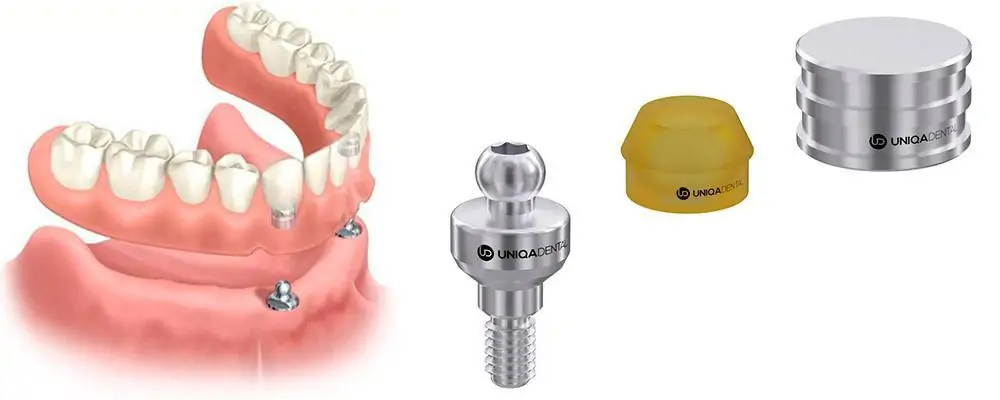
In addition to the price, ball abutments and the entire removable denture platform based on them have the following advantages:
- Ease of Hygiene Procedures: Compared to cement-retained restorations, it is much easier to perform hygiene procedures and soft tissue examinations under the denture. Not all patients use an irrigator or pay sufficient attention to oral hygiene, even if the dentist has explained that the denture is not a living tooth and provided specific care recommendations. Poor care can lead to the accumulation of food debris under the denture, which inevitably leads to inflammation of the soft tissue over time. With removable dentures, the dentist can easily remove the buildup and perform treatment procedures.
- Easy Maintenance: The denture itself is easy to clean and maintain. All procedures can be performed outside the patient’s mouth.
- Compensation for Inaccuracies: Dental ball abutments allow for compensation of inaccuracies in the passive (parallel) fit through elastic inserts between the abutment ball and the retainer cap glued to the denture.
- Improved Quality of Life Compared to Plate Dentures: The prosthesis does not need to be removed and inserted every day. It holds up well and distributes the load evenly over the entire prosthesis. In contrast, with a plate denture, chewing solid food can cause discomfort due to local pressure deforming the plate and transmitting the load to the soft tissues.
- Bone Health Maintenance: The load from chewing is transferred through the implants into the jawbone. This “bone training” helps maintain sufficient bone tissue quantity and condition. With a plate denture, the gingiva can recede, the height of the alveolar ridge reduces, and the bone transforms into a more spongy and fragile type (from D2 to D3 or even D4). After a couple of years of plate prosthesis use, there may be insufficient bone left for dental implants, necessitating complex and costly bone augmentation surgery with a high risk of complications.
- No Special Tools Required: No special tools are required for the placement of ball abutments. They can be installed by hand and removed with standard tools usually available in the dental office. While there is a special key for the installation of ball abutments with a hex head of 2.4 mm (used for screwing the abutment into the dental implant), it is only needed once.
However, there are also disadvantages:
- Need for Regular Maintenance: Patients do not always come for regular check-ups, which can cause the denture to loosen and the elastic caps to fail, necessitating fabrication of a new restoration. Sometimes, it is even necessary to replace the dental abutments (specifically, the abutment itself with a ball attachment), although the root implant remains unharmed. This procedure is time-consuming and can be quite expensive from the patient’s perspective. In contrast, with a multi-unit screw-retained restoration, such problems are minimized. The likelihood of the abutment unscrewing is minimal, and patients can often go five years without issues.
- Lower Initial Stability: The initial stability of a ball-supported denture is lower compared to cemented or screw-supported restorations. While this is manageable with regular maintenance and replacement of elastic inserts, it can lead to long-term wear and tear of both the denture and the ball attachments.
- Reduced Quality of Life Compared to Fixed Restorations: The fit of the ball-retained denture is not as rigid and precise as fixed dental restorations. This can cause discomfort when biting and chewing hard foods, especially fresh vegetables like carrots.
- Less Favorable Compared to Multi-Unit Systems: The disadvantages of the ball and socket attachment system are particularly pronounced when compared to the multi-unit screw attachment system. The screw-retained dental restoration platform performs much better with partial tooth loss when 3–4 teeth are missing in a row.
| Comparison Parameter | Dental Implants with Ball Abutments | Multi-Unit System |
|---|---|---|
| Durability | Medium; the prosthesis and the seats wear out faster. | Very High |
| Stability and Passive Fit of the Restoration | Average; as the elastic insert wears out, stability decreases. Uneven load is transferred through the abutment into the implants. | Very high and does not change over time. The risk of loosening or unscrewing the abutment is minimal. Modern digital CAD/CAM modeling ensures high accuracy, and the prosthesis fits without misalignment or internal stresses. |
| Need for Maintenance | High; check-ups and replacement of elastic inserts must be performed every few months. | Medium; mostly preventive check-ups that are quick and cost-effective for the patient. |
| Cement Procedures in the Patient’s Mouth | No; all procedures with adhesive solutions occur outside the patient’s oral cavity. | No; all procedures with adhesive solutions occur outside the patient’s oral cavity. |
| Aesthetic Appearance | Good; a well-made prosthesis imitates teeth and soft tissue color and texture. | Excellent; the denture closely resembles natural teeth and integrates well with the patient’s gums. |
| Price | Medium; however, the patient may pay more in the long run due to shorter prosthesis lifespan. | High but often a one-time expense. Preventive care and maintenance are typically low-cost. |
Which Ball Abutments Can Be Purchased at Uniqa Dental?
We offer ball attachments compatible with most popular dental implants. See the compatibility chart below:
| Connection Hexagon Socket | Connection Cone 22° |
|---|---|
| Zimmer | Hiossen / Osstem |
| MIS | NobelActive |
| Alpha Bio | Megagen AnyRidge |
| Cortex | Megagen AnyOne |
| Adin |
Please note that we manufacture all prosthetic components, including spherical dental abutments, from titanium-vanadium-aluminum alloy Grade 23. Many competitors use commercially available Grade 4 titanium, which, while strong enough, is notably inferior to Grade 5 and Grade 23 titanium alloys in terms of specific strength. Comparing Grade 5 and Grade 23, the latter has significantly higher ductility and malleability, meaning it resists and deforms elastically over a wider range without fracturing.
In addition, ball abutment instruments are available for the placement of ball abutments and other implant- and restorative-related procedures. Ball abutments are available in different heights to compensate for gingival heights from 0.5 to 7 mm.
Why Is It Profitable to Buy Ball-Attached Abutments from Uniqa Dental?
Our approach to business emphasizes investment in equipment and quality control. We maintain minimal tolerances and high compatibility with the dental implants of major market players. This approach lowers the price of ball attachments compared to similar quality products from other manufacturers.
If you decide to buy components for removable dentures from us, you will receive:
- High Precision and Strength: Our products offer superior strength and resiliency compared to most competitors. You pay only for quality, not for flashy brochures or extravagant promises.
- Free Worldwide Shipping: We offer free shipping on all components, no matter where you are located.
- Fast Delivery within the USA: With warehouses and representative offices in the USA, we ensure quick delivery times.
Exclusive Uniqa Prime Loyalty Program for Ball Attachment Abutments
At Uniqa Dental, we value our customers and their trust in our products. That’s why we’ve created the Uniqa Prime Loyalty Program, designed to offer additional benefits to dental professionals who choose our ball attachment abutments and other products. Here’s what you can expect when you join:
- $500 Welcome Bonus: Get $500 for registering and placing your first order online directly through our website.
- Cash Back Rewards: Earn cash back on every dollar you spend on ball attachment abutments and related components.
- Bulk Purchase Discounts: Receive up to 35% off when your spending exceeds $5,000, perfect for stocking up on ball attachment systems.
- Review Rewards: Earn additional rewards for sharing your experiences with our ball attachment abutments through reviews.
- Priority Support: Get faster responses to your queries about ball attachment systems and their applications.
Join Uniqa Prime today to start maximizing your benefits and savings on our ball attachment abutments and all other Uniqa Dental products.
Private Label Opportunities for Ball Attachment Abutments
For dental practices and implant companies looking to establish or enhance their brand, Uniqa Dental offers private label opportunities for our ball attachment abutments and related components. Here’s how our private label service can benefit your business:
- Brand Enhancement: Offer high-quality ball attachment systems under your own brand name, increasing recognition and trust among your patients or customers.
- Customization: We can tailor the packaging and labeling of ball attachment components to match your brand identity while maintaining our superior quality standards.
- Competitive Edge: Differentiate yourself in the market by offering a unique line of ball attachment abutments backed by Uniqa Dental’s expertise and manufacturing excellence.
- Flexible Ordering: Benefit from our low minimum order quantities and fast turnaround times, allowing you to manage inventory of ball attachment systems efficiently.
- Quality Assurance: Rest assured that all private label ball attachment products meet the same high standards as our branded items, including CE and ISO 13485 certifications.
- Technical Support: Receive comprehensive technical support for your private label ball attachment systems, ensuring you can provide expert guidance to your customers.
Whether you’re a growing dental practice looking to offer your own line of ball attachment components or an established implant company seeking to expand your product range, our private label service for ball attachment abutments can help you achieve your goals.
Contact our dedicated private label team to discuss how we can help you create a unique product line of ball attachment systems that stands out in the competitive dental implant market.
Additionally, you can order samples for testing. Leave a request, and we will send an introductory kit on special terms.

